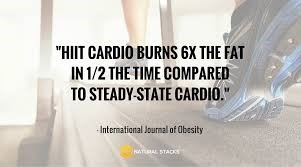HIIT vs. Steady State Cardio
Posted: July 24, 2017 at 4:08 pm, Last Updated: July 24, 2017 at 4:12 pm
For many years individuals have steered away from high intensity cardio because of the thought that it would break down muscle tissue to fuel the exercise. If you asked me, that wouldn’t be fun at all.
Which Burns More Calories?
While lower-intensity cardio has been shown to burn a higher percentage of calories from fat, your body burns fewer calories overall. That means that to burn as many calories as High-intensity interval training (HIIT), one would have to train for a considerably longer time.  In this day and age, most individuals barely have enough time to fit in 60 minutes of resistance training, let alone another 60 minutes of cardio.
In this day and age, most individuals barely have enough time to fit in 60 minutes of resistance training, let alone another 60 minutes of cardio.
The real secret of cardio lies in the number of calories you burn, not during the workout, but during the rest of the day. Metabolism is a beautiful thing when it is working in your favor.
What About the Science Behind HIIT?
HIIT is a form of cardio that involves short intervals of high-intensity training (such as sprints) combined with “rest” intervals of low-intensity activity such as walking at a slow pace. Compared to typical steady-state cardio sessions that last anywhere from 30 minutes to 60 minutes, HIIT is a drastic contrast.
A study in Australia (Trapp, 2008) reported that females who followed a HIIT program for 20 minutes burned 6 times more fat as compared to a group of women who performed 40 minutes of steady-state cardio at 60 percent of their maximum heart rate. The greatest advantage of HIIT has been found to be the increased metabolic rate after a workout.
But Where Should I Begin?
Being a part of George Mason University’s Recreation facilities gives you access to Personal Trainers that are here to help you meet your goals. Stop by the office located over at the GMU Aquatic and Fitness Center to learn how to start your fitness journey today!
Article by: Cullen Guthrie (NASM Certified Personal Trainer)



